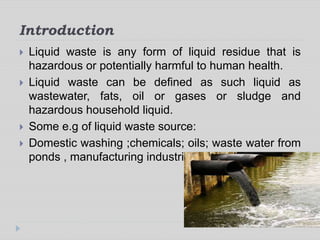The Only Guide for Reclaim Waste
The Only Guide for Reclaim Waste
Blog Article
How Reclaim Waste can Save You Time, Stress, and Money.
Table of ContentsSome Known Incorrect Statements About Reclaim Waste The Only Guide to Reclaim WasteIndicators on Reclaim Waste You Need To KnowReclaim Waste for DummiesGetting My Reclaim Waste To Work
Discover the types, events, and types of liquid waste. Domestic sewage waste describes the waste and products from a household sewage-disposal tank. This type of waste is created by humans in residences, colleges, and other buildings. This only consists of septic systems that have a drainpipe field. The correct management and disposal of domestic sewage waste call for liquid waste to be transferred to a sewage treatment plant where the proper methods and equipment are put on purify and dispose of waste.
Business waste frequently includes prospective hazards, such as flammable materials or a mix of liquid and solid waste items, and requires an advanced and comprehensive disposal procedure. The disposal of business waste typically entails the filtering of waste before transport to make sure safe and appropriate disposal. Industrial waste is created from by-products and runoff of industrial processes and production.
This kind of waste can not utilize the same sewer monitoring transport or processes as septic or business liquids. The commercial waste management process calls for the assessment and screening of liquid waste prior to it goes through the disposal procedure (industrial wastewater treatment). Drainage waste is the liquid waste that originates from runoff and excess stormwater in very inhabited locations or cities
Drainage waste can cause contamination and flooding otherwise taken care of correctly. Discover more about sewer cleansing and waste management. Ensuring proper waste management can prevent calamities and reduce ecological harm. Both people in domestic setups and professionals in industrial or manufacturing markets can take advantage of comprehending the procedures and laws of fluid waste administration.
The Best Guide To Reclaim Waste
Contact PROS Solutions today to find out about our waste management and disposal services and the correct methods to care for the liquid waste you produce.
(https://ameblo.jp/reclaimwaste1/entry-12874802223.html)This supposed 'wastewater' is not only an essential resource however, after treatment, will certainly be released to our land, rivers or the sea. Utilized water from commodes, showers, bathrooms, kitchen area sinks, laundries and commercial procedures is understood as wastewater.

water used to cool down machinery or tidy plant and devices). Stormwater, a type of wastewater, is drainage that moves from agricultural and urban locations such as roofings, parks, yards, roadways, paths and rain gutters right into stormwater drains, after rainfall. Stormwater streams unattended straight to regional creeks or rivers, eventually getting to the ocean.
The smart Trick of Reclaim Waste That Nobody is Talking About
In Queensland, the majority of wastewater is treated at sewage treatment plants. Wastewater is moved from domestic or industrial sites via a system of drains and pump terminals, understood as sewage reticulation, to a sewer therapy plant.
The Division of Natural Resources encourages neighborhood federal governments about handling, operating and maintaining sewage systems and treatment plants. In unsewered locations, regional governments may need owners to install private or house sewer treatment systems to treat domestic wastewater from toilets, kitchen areas, shower rooms and laundries. The Division of Natural Resources authorizes the usage of household systems when they are verified to be reliable.
In some new communities, treatment of some stormwater to remove litter, sand and crushed rock has begun utilizing gross contaminant traps. Wastewater treatment happens in 4 stages: Removes solid issue.
Wastewater after that flows right into large containers where solids clear up and are gotten rid of as sludge. Grease and residue are skimmed from the surface. Makes use of tiny living organisms called micro-organisms to damage down and get rid of remaining liquified wastes and great fragments. Micro-organisms and wastes are integrated in the sludge. Removes nitrogen and phosphorus nutrients that could trigger algal blooms in our rivers and threaten water life.
A Biased View of Reclaim Waste
Nutrient elimination is not offered in all sewer treatment plants due to the fact that it needs costly specialist equipment. It is ending up being more typical in Queensland. Clear fluid effluent generated after therapy may still have disease-causing micro-organisms. If this effluent is launched right into rivers such as rivers or the sea, the micro-organisms will at some point die out.

The majority of wastewater moves into the sewerage system. Under the Act, neighborhood federal governments administer approvals and licences for environmentally relevant activities (Periods) involving wastewater launches that could have a local influence.
The Ultimate Guide To Reclaim Waste
Tracking supplies accurate details concerning water high quality and can validate that permit conditions are being met. The info gotten through monitoring offers the basis for making water quality decisions.
Report this page